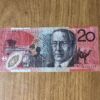What is the Australian Dollar (AUD)?
The Australian dollar refers to Australia’s official currency and is abbreviated as AUD. It is also the official currency of several regions, such as Norfolk Island, Christmas Island, and Keeling Islands. It is also currently used as the official currency by three sovereign Pacific Island nations – Nauru, Kiribati, and Tuvalu.

The Reserve Bank of Australia (RBA), Australia’s central bank, manages AUD and determines the country’s monetary policy and issues and regulates the money supply. The Australian dollar was adopted on February 14, 1966 and replaced the Australian pound at a conversion rate of 2 AUD per Australian pound.
Summary
- The Australian Dollar refers to Australia’s official currency and is abbreviated as AUD.
- The Reserve Bank of Australia (RBA), Australia’s central bank, manages AUD and determines the country’s monetary policy and issues and regulates the money supply.
- Australia is one of the biggest exporters of iron ore and coal in the world; hence, the value of AUD depends heavily on commodity prices.
History of Australian Dollar
Before the introduction of the Australian dollar in 1966, the Australian pound was the currency of Australia. Similar to the British pound, the Australian currency was divided into 20 shillings, which were further divided into 12 pence. The circulation of the Australian pound began in 1910 at the same level as the pound sterling. In 1931, its value differed from that of the pound sterling following a currency devaluation.
In 1902, a special committee of the House of Representatives, headed by George Edwards, proposed that Australia introduce a decimal currency based on florin. The Banking Royal Commission, in 1937, proposed that Australia introduce a decimal coinage scheme. In August 1960, the Decimal Currency Committee reported supporting decimalization and proposed that a new currency be adopted in February 1963, with the introduction modeled on the substitution of the South African pound in South Africa with the rand.
In 1967, the sterling got devalued against the USD. However, AUD kept its peg to the USD at the rate of 1 AUD = 1.12 USD, and thus officially left the sterling system. The first paper notes of the Australian dollar were published in 1966 in denominations of $1, $2, $10, and $20. The $5 note was circulated in 1967, the $50 note in 1973, and the $100 note in 1984.
The Reserve Bank of Australia issued polymer banknotes, specifically polypropylene polymer, for the first time in 1988, marking the centennial anniversary of the European colonization of Australia. All Australian notes put in circulation now are polymer notes. The country was the first to produce and use notes made of polymer.
Current Australian Dollar and Forex Markets
A new series of AUD polymer notes is being unveiled, starting with the 5 AUD notes introduced in September 2016. A new 10 AUD note was launched on September 20, 2017, and a new 50 AUD note was issued on October 18, 2018. The new 20 AUD bill was launched on October 9, 2019, while the new 100 AUD note was launched on October 29, 2020. Currently, denominations of 5, 10, 20, 50, and 100 AUD are in circulation. With respect to coins, 1 AUD and 2 AUD, and 5, 10, 20 and 50 cents are presently in use.
Australia is one of the largest exporters of iron ore and coal in the world; hence, the value of AUD depends heavily on the prices of commodities. During the 2015 energy recession, oil prices reached a ten-year low, and the prices of both iron ore and coal plunged to a recent low.
As a consequence, the Australian dollar was drastically devalued, falling more than 15% against the United States dollar and reaching equilibrium with the New Zealand dollar (NZD) – a level not seen since the 1970s.
The importance of AUD among forex traders is related to the country’s geography, geology, and government policy. Australia is one of the richest countries in the world in terms of natural wealth, including metals, steel, gems, meat, and fur. It also exerts a powerful influence on nearby regions.
In 2019, the AUD was the fifth most exchanged currency in the world and accounted for about 7% of trade in foreign exchange transactions worldwide. The high level of trade in Australia is partially due to the country’s economic and political stability and minimal government interference in the foreign exchange industry.
| Grades | Grade A, Grade B |
|---|---|
| Quantity | 500 Notes, 1000 Notes, 1000 Notes, 2500 Notes |












Reviews
There are no reviews yet.